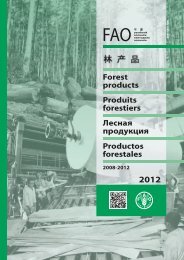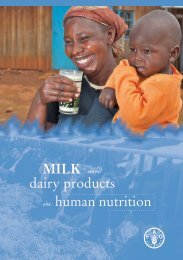You also want an ePaper? Increase the reach of your titles
YUMPU automatically turns print PDFs into web optimized ePapers that Google loves.
XX<br />
SYMBOLS USED IN THE TABLES<br />
CUM<br />
Cubic metre<br />
MT<br />
Metric ton<br />
C<br />
Coniferous<br />
NC<br />
Non-coniferous<br />
$ United States dollar<br />
PRODUCT NAMES AND DEFINITIONS<br />
General terms and forest product names used in the yearbook<br />
are listed below and briefly defined. Where possible the<br />
definitions used follow Classification and definitions of forest<br />
products, FAO, Rome, 1982. Some of these have been refined<br />
for use with the joint forest products questionnaire.<br />
General terms<br />
Coniferous<br />
All woods derived from trees classified botanically as<br />
Gymnospermae, e.g. fir (Abies), Paraná pine (Araucaria), deodar<br />
(Cedrus), ginkgo (Ginkgo), larch (Larix), spruce (Picea), pine,<br />
chir, kail (Pinus), etc. (These are also generally referred to as<br />
softwoods).<br />
Non-coniferous<br />
All woods derived from trees classified botanically as<br />
Angiospermae, e.g. maple (Acer), alder (Alnus), ebony<br />
(Diospyros), beech (Fagus), lignum vitae (Guaiacum), poplar<br />
(Populus), oak (Quercus), sal (Shorea), teak (Tectona),<br />
casuarina (Casuarina), etc. (These are generally referred to as<br />
broadleaves or hardwoods).<br />
Tropical<br />
Tropical timber is defined in the International Tropical Timber<br />
Agreement (2006) as follows: “Tropical wood for industrial<br />
uses, which grows or is produced in the countries situated<br />
between the Tropic of Cancer and the Tropic of Capricorn. The<br />
term covers logs, sawnwood, veneer sheets and plywood.” For<br />
the purposes of this yearbook tropical timber only includes<br />
non-coniferous products. The term is only used here in<br />
reference to non-coniferous industrial roundwood.<br />
Other<br />
Countries that are not tropical (as defined above). The term is<br />
only used here in reference to non-coniferous industrial<br />
roundwood.<br />
Removals<br />
The volume of all trees, living or dead, that are felled and<br />
removed from the forest, other wooded land or other felling<br />
sites. It includes: natural losses that are recovered (i.e.<br />
harvested), removals during the year of wood felled during an<br />
earlier period removals of non-stem wood such as stumps<br />
and branches (where these are harvested) and removal of<br />
trees killed or damaged by natural causes (i.e. natural losses),<br />
e.g. fire, windblow, insects and diseases. It excludes: bark<br />
and other non-woody biomass and any wood that is not<br />
removed, e.g. stumps, branches and tree tops (where these<br />
are not harvested) and felling residues (harvesting waste). It is<br />
reported in cubic metres underbark (i.e. excluding bark).<br />
Where it is measured overbark (i.e. including bark), the volume<br />
has to be adjusted downwards to convert to an underbark<br />
estimate.<br />
Production<br />
The solid volume or weight of all production of the products<br />
specified below. It includes: the production of products that may<br />
immediately be consumed in the production of another product<br />
(e.g. wood pulp, which may immediately be converted into paper<br />
as part of a continuous process). It excludes: the production of<br />
veneer sheets that are used for plywood production within the<br />
same country. It is reported in cubic metres of solid volume in<br />
the case of roundwood, sawnwood and wood based panels and<br />
metric tons in the case of charcoal, pulp and paper products.<br />
Imports<br />
Products imported for domestic consumption or processing<br />
shipped into a country. It includes: imports into free economic<br />
zones or for re-export. It excludes: "In-transit" shipments. It is<br />
reported in cubic metres of solid volume or metric tons and<br />
values normally include cost, insurance and freight (i.e. CIF).<br />
Exports<br />
Products of domestic origin or manufacture shipped out of the<br />
country. It includes: exports from free economic zones and reexports.<br />
It excludes: "In-transit" shipments. It is reported in<br />
cubic metres of solid volume or metric tons and values are<br />
normally recorded as free-on-board (i.e. FOB).<br />
Unit values<br />
Unit values have been obtained by dividing the total value of<br />
trade by the total volume of trade. The figures for exports<br />
represent average FOB values, while those for imports represent<br />
average CIF values.<br />
Consumption<br />
Consumption is Apparent Net Consumption, which equals<br />
production plus imports minus exports; it can therefore, only be<br />
calculated when data are available for all three elements.<br />
Forest product aggregates and names<br />
The names of individual forest products and product aggregates<br />
are listed below in the order in which they occur in the tables<br />
later on. Separate definitions are not provided for coniferous (C)<br />
and non-coniferous (NC) components where the general<br />
definition given above applies. Unless indicated otherwise, each<br />
forest product category includes both coniferous and nonconiferous<br />
components. A summary, showing how all of the<br />
product categories and aggregates are linked together, is given<br />
in a table at the end of this section.<br />
ROUNDWOOD<br />
Roundwood<br />
Roundwood (C)<br />
Roundwood (NC)<br />
All roundwood felled or otherwise harvested and removed. It<br />
comprises all wood obtained from removals, i.e. the quantities<br />
removed from forests and from trees outside the forest, including<br />
wood recovered from natural, felling and logging losses during<br />
the period, calendar year or forest year. It includes: all wood<br />
removed with or without bark, including wood removed in its<br />
round form, or split, roughly squared or in other form (e.g.<br />
branches, roots, stumps and burls (where these are harvested)<br />
and wood that is roughly shaped or pointed. In the production<br />
statistics, it represents the sum of: wood fuel, including wood<br />
for charcoal; sawlogs and veneer logs; pulpwood, round and<br />
split; and other industrial roundwood. In the trade statistics, it<br />
represents the sum of: industrial roundwood - wood in the<br />
rough; and wood fuel, including wood for charcoal. It is reported<br />
in cubic metres underbark (i.e. excluding bark). The statistics<br />
include recorded volumes, as well as estimated unrecorded<br />
volumes as indicated in the notes.<br />
Wood Fuel, including Wood for Charcoal<br />
Wood Fuel, including Wood for Charcoal (C)<br />
Wood Fuel, including Wood for Charcoal (NC)<br />
Roundwood that will be used as fuel for purposes such as<br />
cooking, heating or power production. It includes: wood<br />
harvested from main stems, branches and other parts of trees<br />
(where these are harvested for fuel) and wood that will be used<br />
for charcoal production (e.g. in pit kilns and portable ovens). The<br />
volume of roundwood used in charcoal production, is estimated<br />
by using a factor of 6.0 to convert from the weight (MT) of<br />
charcoal produced to the solid volume (CUM) of roundwood<br />
used in production. It is reported in cubic metres underbark<br />
(i.e. excluding bark).







